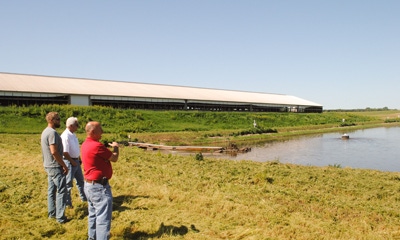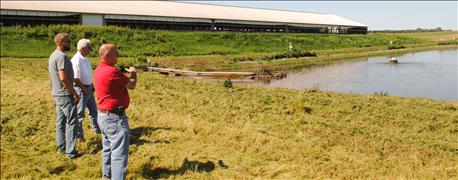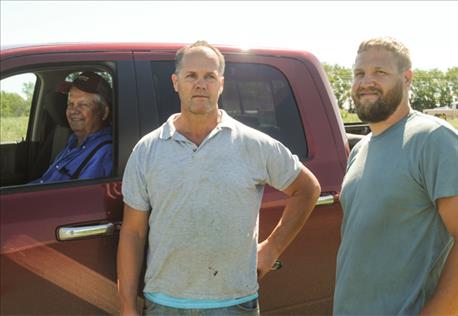
For O and W Dairy near Royal, it’s all about water use and nutrient efficiency, herd health and TLC for the cows. Warren Snodgrass started milking cows with his father when the family was milking by hand and using kerosene lanterns for light. Today, Snodgrass is still dairying with wife Merry, son Roy, grandsons Heath and Seth, and other family members and employees, but they have come a long way since those days of milking by hand.

UNIFORM FERTIGATION: Dan Lyons, Petersen Ag Systems (right); Heath Snodgrass (left); and Kerwin Miller, eXpertCompany marketing technician, inspect a newly installed Circul-O2-Rater unit on Snodgrass’ older lagoon.
“In 2000, we made a major investment to upgrade our facilities, increase our herd and completely change the way we do things,” Warren says. “We visited other dairies across the country, including several in New York state, to learn about the types of systems out there and how they were working.”
The system they eventually built included new freestall loafing barns with sand stalls and a unique flushing system that uses lagoon water to flush the floors at regular intervals each day.
“Through most of the year, we use lagoon water to flush the system,” Heath explains. “We use fresh water in the summer, partly because the cooler water tends to cool the barns and the cows,” he says. “But most of the year, we recycle lagoon water. When the system flushes, it washes the cows’ feet and helps keep the floors clean. This way, we reduce feet problems and improve the overall health of the cows,” he says.

ALL IN THE FAMILY: Warren Snodgrass (in pickup), his son Roy (middle), and grandson Heath along with another grandson, Seth (not pictured), continue to improve efficiencies on the family dairy near Royal.
When the new barns and milking parlor were built, the original lagoon seemed quite large, at about 9 feet deep. But fertigating from that anaerobic lagoon over time became a maintenance issue for sprinkler equipment, Heath says. Corrosion from the lagoon water ruined sprinkler packages. This past year, under consultation with Dan Lyons, Petersen Ag Systems, the family added Circul-O2-Rater units to the lagoon to change the system from anaerobic to aerobic, reducing odor, improving nutrient availability in the lagoon water for fertigation and changing the composition of the lagoon water for flushing into clean, less corrosive water.
The family recently built a larger, second lagoon that is much deeper, to handle more of the fluids. Heath says that in the coming months, Circul-O2-Rater units will be installed on that lagoon as well. The units, produced and marketed by eXpertCompany, allow water from the aerobic lagoons to be pumped through regular center-pivot sprinkler packages without the corrosion and clogging concerns. “It improves the uniformity of our irrigation,” Heath says.
He also notes that dairies produce a great volume of solid manure. To break solids down, about 10 years ago they added a manure press that separates the largest amount of solids from the manure through a system of screens, and presses the liquids from the manure to produce a fine-textured, fluffy product that can be distributed on fields as fertilizer.
As the family looks to slowly expand their cow numbers over time from 700 up to 850, Heath says that these systems are providing important efficiencies and are helping the dairy recycle water and nutrients, not only in the barns, but also on their crops.
About the Author(s)
You May Also Like






